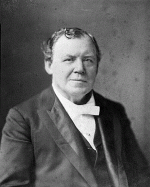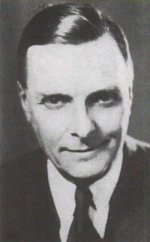


From left to right: F. Gutekunst, Ignatius Loyola Donnelly (c. 1898). Courtesy Minnesota Historical Society, Saint Paul, Minnesota. Anonymous, William Comyns Beaumont (date unknown). Bob Kobres, Immanuel Velikovsky (1978)
July 23, 2012
In bestsellers published in 1882 and 1883, the American politician and amateur scientist Ignatius Loyola Donnelly (1831-1901) perpetuated the enthralling hypothesis of a comet’s near-collision with the earth, provoking mayhem in the form of floods, fires, mass extinction and tectonic changes on a global scale.
Donnelly specifically appealed to the comet’s interruption of the earth’s rotation as a potential explanation for the prolonged day of Joshua: ‘Were the heat, the conflagrations, and the tearing up of the earth’s surface caused by such an arrestment or partial slowing-up of the earth’s revolution on its axis?’ The same argument resurfaced in Velikovsky’s account, where the comet doubled as Venus.
William Comyns Beaumont (1873-1956) was an eccentric British journalist and lecturer, whose aberrant astronomical speculations, published between 1925 and 1932, find startling counterparts in Velikovsky’s books, which appeared some 2 decades afterwards: many geological features as well as mass extinctions were due to a cometary collision; cometary tails deposited vermin as well as hydrocarbons; religion arose from the fear and worship of comets; Saturn was a former comet responsible for the Biblical deluge; Venus’ apparent colour, diameter and orbit changed in historical times; countless deities were identified with planets or commemorated a cometary dragon; cosmic lightning was of paramount importance; the year originally lasted 360 days and catastrophes necessitated calendar revisions; and scholars had erroneously inflated ancient chronology by several centuries. To top it off, Beaumont had associated his cometary planet Saturn with a smattering of catastrophic events dated to the 14th century BCE, linked the intruder to the Greek myth of Phaethon and argued that it spawned planetary offspring in the form of Jupiter. It goes without saying that all of these ideas carry a distinct Velikovskian flavour avant la lettre. Even drastic revisions of historical geographic locations were a shared interest of both writers.
In publications from 1936 to 1959, an obscure, possibly Austrian researcher using the pseudonym Hans Schindler Bellamy (1901-1982) continued the theme of myth as the ‘fossil history’ of dramatic environmental events. Building on Hanns Hörbiger’s theory of moons spiralling into the sun unless intercepted by planets, Bellamy asserted that human traditions recorded the disintegration of a former moon as well as the capture of the present one ‘out of transterrestrial space where, not so very long ago, it existed as an independent planet’; as a dazzling comet, this moon interacted with the earth in ways that gave rise to the rich mythical genres of ‘deluge and dragon-fight, earth-end and earth-creation, of gods and heroes’. Velikovsky’s view, as noted, incorporated the notions of a recent acquisition of the moon and a giant planet-turned-comet menacing the earth, though this protagonist was Venus instead of the moon.
In a populist work released in 1938, the American (?) colonel Alexander Pavlovitch Braghine (1878-1942) extensively mined mythological traditions in his efforts to reconstruct the cosmic cataclysms that had apparently occurred in two time frames, at c. 10,000-9,000 BCE and at c. 4,000 BCE. Starting again from Hörbiger’s moon theory, the thrust of Braghine’s argument was that a giant cometary interloper – perhaps Halley’s Comet – caused a former moon to impact onto the earth and the present moon as well as Venus to assume their current orbits: ‘The irruption of the said giant comet into the solar system produced the following modifications: Venus came nearer to the sun and therefore became less visible to us than before, the Moon was thrown aside, and, entering into the Earth’s gravitational field, became an earthly satellite, and our old, small satellite, thrown still nearer to our planet, fell upon its surface.’ Geological disasters, tilting of the earth’s rotational axis, a gradual diminution in the amplitude of the axis’ nutation and adjustments to calendars ensued. Seriated epochs of catastrophe, snaring of the moon and alterations in the rotational properties of Venus and the earth, with their concomitant calendar reforms, are all part and parcel of Velikovsky’s writings, as seen.
This concise listing of ideological precursors suffices to prove that virtually none of Velikovsky’s arguments were original. In a way, Velikovsky was merely the twelfth in a lineage of free-thinkers that continuously recycled the same core elements of a theory of punctuated cosmic catastrophism. Even Velikovsky’s musings on the potency of the electromagnetic force in space could draw on precedents such as the concepts of ‘charged planets’ and ‘electric comets’ pondered by Elias Loomis (1868), Richard Anthony Proctor and Osborne Reynolds (1871), Sir William Huggins (1885) and Kristian Birkeland (1913).
In retrospect, Velikovsky’s immensely influential reconstruction boils down to a spirited rehash of assorted ideas lifted from others’ works, borrowed along with the same tired examples drawn from myth and history. All that is novel appears to be limited to specifics, such as the particular details of the revised chronology, the relocation of the land ‘Punt’, ‘name games’ such as ‘Persians’ (prst) meaning ‘Philistines’ (plst) or ‘first-born ones’ (bǝkōrīm) meaning ‘chosen ones’ (bāḥūrīm), the preferential treatment given to Hebrew mythology, or the idea that the comet Venus was expelled from Jupiter. Sadly, these innovations are also the weakest aspects of Velikovsky’s theory, unlike the general underlying notions that had been around for centuries.
None of this detracts from the potential value and quality of the mythological data and the favourite thought experiments promulgated for so long by catastrophist thinkers. However, Velikovsky’s resolution not to credit any of the above chain of authorities, except Whiston, Donnelly and Bellamy, seems profoundly questionable. Was Velikovsky unaware of some of these works, such as Boulanger’s unpublished manuscripts, Carli’s letters or Radlof’s pamphlet? Was he loathe to cite fringe writers, such as Beaumont? Or did a desire to arrogate the most spectacular insights to himself constitute an ulterior motivation? Revealing is Velikovsky’s unpublished statement that he ‘came across the name’ of Boulanger ‘very late’ in his research, in 1963, admitting that Boulanger was ‘my predecessor’. Yet even so, surely Velikovsky, widely read, could not have missed the output of his contemporaries Beaumont and Braghine?
Whatever the case, critics rarely levelled an accusation of plagiarism against Velikovsky. Instead, they vilified the ideas themselves more vociferously than the modern era had ever witnessed. Clearly, what was at stake for the academic community was something far graver than the possible malpractice of a single scholar – the prospect of a catastrophist worldview. The illustrious ‘twelfth imam’ of catastrophism had to remain hidden from the intellectually curious. Yet in all likelihood, the Velikovskys of the past will continue to reincarnate until the giant will be tall enough not to shoulder the burden of dogmatic thought any longer.
Rens Van Der Sluijs
Books by Rens Van Der Sluijs:
Traditional Cosmology: The Global Mythology of Cosmic Creation and Destruction
Volume One: Preliminaries Formation
The Mythology of the World Axis
The World Axis as an Atmospheric Phenomenon
With thanks for the legwork done by Alfred de Grazia and Han Kloosterman.












